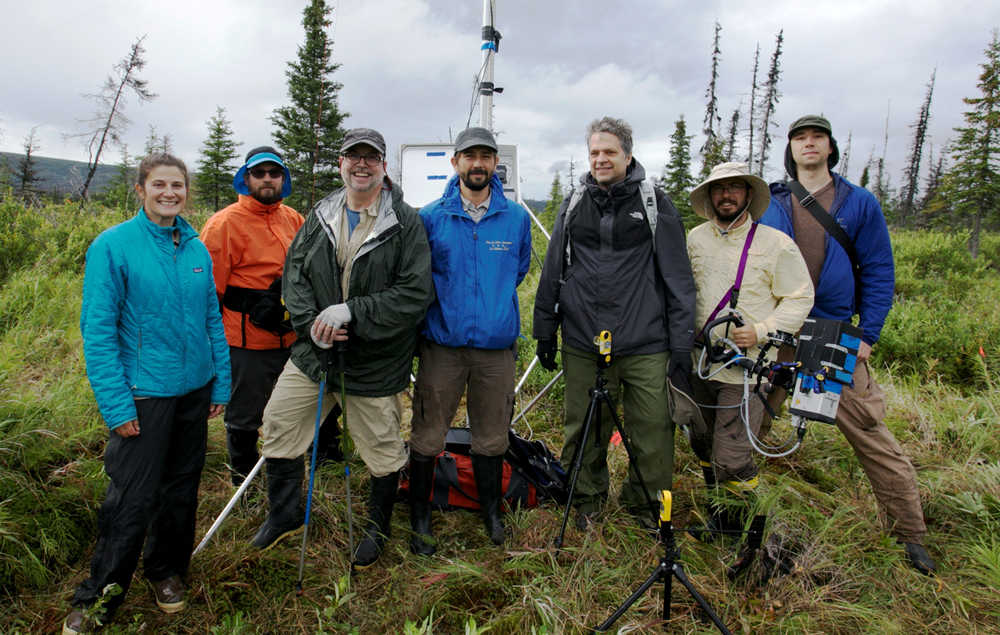Recently, I and other researchers from the University of Arizona, Michigan State University, and the University of Washington visited the Kenai Peninsula to collaborate with biologists at the Kenai National Wildlife Refuge to investigate tree mortality and how it affects microclimate conditions near the ground, such as shading and temperature. Funded by the National Science Foundation, our team is interested not only in the changes locally, but if these changes could influence other areas as far away as the Amazon Basin in South America.
Our team lugged a lot of equipment to measure how the forest structure and the microclimate changed after tree mortality. We compared two plots: one where most trees had died and another where only a few had died.
At each plot, we hoisted up a mast that allowed us to measure solar radiation above the trees as well as temperature, relative humidity and wind conditions from there all the way down to the ground. To measure the forest structure, we took photographs with a fish-eye camera lens facing the sky that will be used to calculate how much shading occurs at a certain place and time. Additionally, we brought a laser-based instrument called LiDAR (Light detection and Ranging) that scans the vegetation structure and provides a detailed picture of the complicated branch and leaf structure of the plots. These can be related to all the other measurements of microclimate.
Together, these measurements let us characterize near-ground conditions such as albedo and air turbulence in the atmosphere. Albedo is the amount of solar radiation reflected by the land surface and is related to surface properties like its color. When trees such as the dark spruce of the Kenai are replaced by other types of vegetation, for example lighter-colored grasses, the change in energy absorbed near the earth’s surface due to change in albedo alters the transfer of moisture and energy to the atmosphere and influences the amounts of evaporation and tree transpiration.
Also, when tree structure is replaced by a different type of vegetation, such as grasses, wind patterns near the ground change. Near-ground wind currents are responsible for transferring moisture in the form of water vapor to the atmosphere. This moisture eventually produces rainfall either locally or elsewhere when transported by high atmospheric currents.
In a changing climate, droughts accompanied by higher temperatures are becoming more frequent. Associated with these droughts are large-scale tree die-off events that can be amplified by the presence of pests such as bark beetles, as well as by the potential occurrence of fire. Tree die-off events are widespread in temperate regions around the world. Locally, the Kenai Peninsula has experienced such large-scale tree mortality in response to bark beetle infestations and, more recently, forest fire.
Even the tropics are not exempt. In the Amazon, tree mortality has occurred when there are particularly dry seasons produced by strong El Niño events. Vegetation changes resulting from tree mortality, such as those observed on the Kenai Peninsula, can have many effects. When trees die, this changes the microclimate near the ground in terms of shading, temperature and other variables. This microclimate influences many other environmental factors such as what plants will grow in there, will new seedlings reestablish the trees that were lost or will new species come in, and how quickly will water in the soil evaporate back into the air.
The changes in microclimate after many trees die is important not only locally, but can also have effects on the climate at larger scales. The microclimate near the ground surface interacts with the atmosphere above it. If the microclimate of a large enough area changes substantially, it can influence how the atmosphere circulates, thereby affecting other areas as well. Because tree die-off has been occurring over such large areas, scientists have begun to ask if large scale tree die-off, as has occurred on the Kenai Peninsula and in many other large areas in North America, could affect all the way down to the Amazon Basin in South America.
Scientists call this type of effect “atmospheric teleconnections”. The reason we think this might be possible is because a recent study calculated that if trees were added to grasslands—something being discussed as a way to reduce some of the carbon in the atmosphere that is contributing to warming—there is a potential teleconnection with the Amazon. Now we are asking if losing trees from forests could also have a similar effect. By understanding the structural and functional effects of forest die-off, and through the use of climate models, researchers expect to better understand the atmospheric feedbacks and interactions that can potentially develop.
So the next time you tromp through a once-forested area on the Kenai that is now an open grassland, consider that this change may influence happenings in the Amazon. It is indeed a very small world.
Professor Palacio is at the Universidad de Antioquia in Medellín-Colombia. For more information on the Kenai National Wildlife Refuge visit http://kenai.fws.gov or http://www.facebook.com/kenainationalwildliferefuge.

